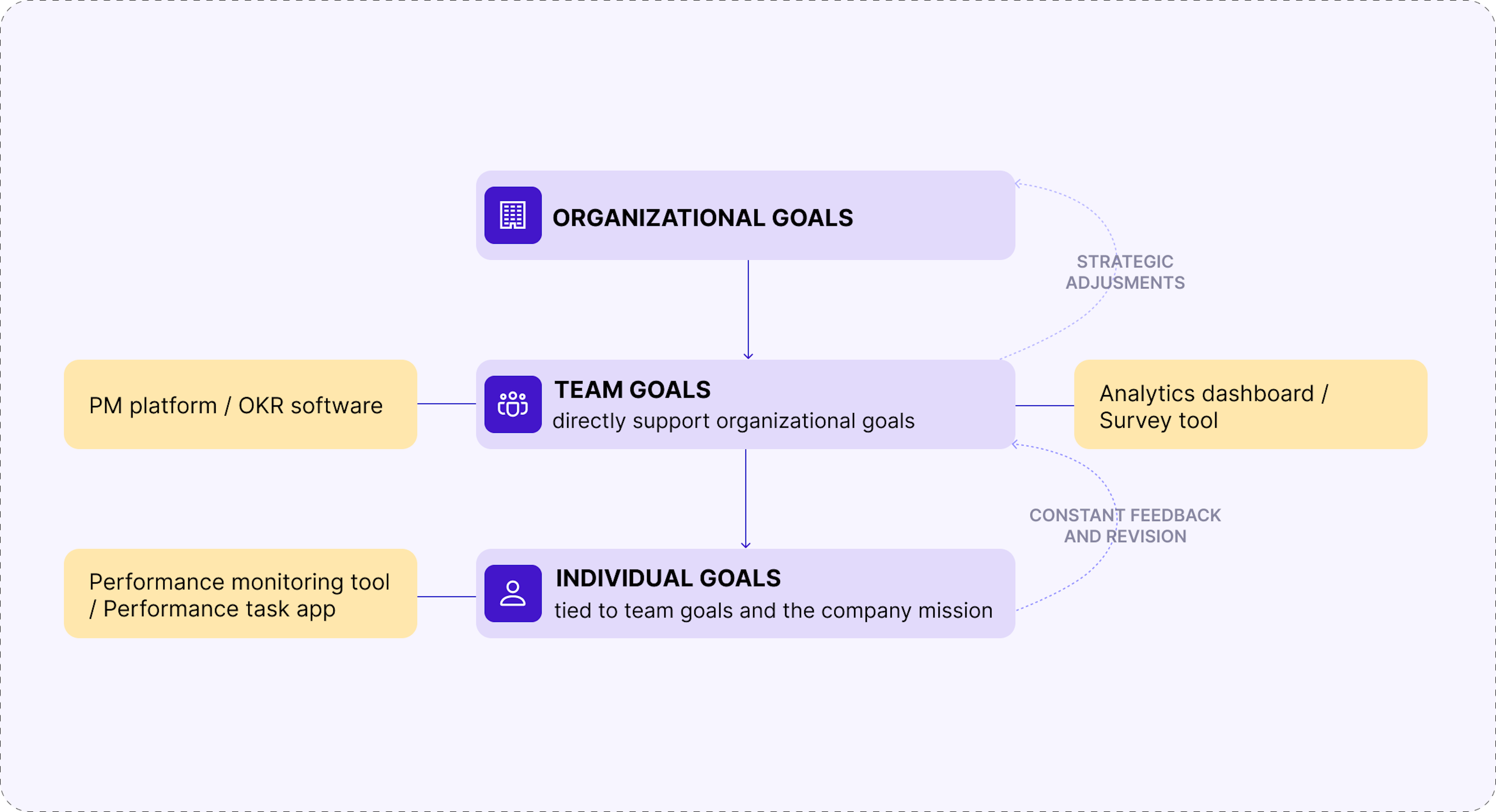Performance Management Glossary: Key Terms
Definition of Goal alignment
What is goal alignment in performance management?
Goal alignment is the strategic process of synchronizing personal, team, and organizational goals so that daily actions and long-term strategies support the company's mission and vision. This approach creates a unified direction, reduces conflicting priorities, and ensures that everyone's contributions are meaningful and measurable.
Key elements of goal alignment in performance management:
- Cascading organizational goals down to teams and individuals.
- Creating clear connections between daily tasks and strategic outcomes.
- Using measurable objectives to track progress and success.
- Facilitating transparent communication about priorities and expectations.
When goal alignment is achieved, employees understand how their work impacts the broader business, leading to greater motivation, engagement, and accountability.
Why is goal alignment important in performance management?
Goal alignment is a cornerstone of effective performance management because it drives both business results and employee satisfaction. Here's why it matters:
- Boosts productivity and efficiency: Aligned goals eliminate redundant efforts and ensure resources are focused on the highest priorities.
- Enhances engagement: Employees who see how their work contributes to the company's success are 3.5 times more likely to be engaged.
- Improves clarity and direction: Clear alignment reduces confusion, so everyone knows what's expected and how to measure success.
- Enables faster achievement of strategic goals: When everyone pulls in the same direction, organizations reach milestones more quickly.
- Fosters accountability: Alignment creates a culture where individuals and teams are responsible for outcomes, not just activities.
- Strengthens collaboration: Teams with shared objectives are more likely to support each other and innovate together.
Industry insight: According to a research by the business consulting firm LSA Global, highly aligned companies are 58% more likely to increase revenue and 72% more profitable than those with poor alignment.
What are the 3 pillars of goal alignment?
Achieving true goal alignment depends on 3 foundational pillars:
1. Organizational goals
These are the high-level strategic objectives that define the company's direction and success. They act as a "north star" for all business activities.
2. Team goals
Each department or team sets specific objectives that directly support the organizational goals. Team goals bridge the gap between strategy and execution.
3. Individual goals
Every employee has personal objectives that are linked to their team's goals and, by extension, the company's mission. This ensures that daily work is always relevant and impactful.
When these three pillars are aligned, companies create a cohesive environment where everyone understands their role in the bigger picture, leading to stronger performance and a sense of shared purpose.
What can help team leaders and employees achieve goal alignment?
Achieving and maintaining goal alignment is an ongoing process that requires the right tools, communication, and leadership. Here's how organizations can support alignment at every level:
- Set clear, measurable objectives
Use frameworks like SMART goals or OKRs to ensure objectives are specific, measurable, achievable, relevant, and time-bound. - Communicate transparently
Share organizational goals regularly and explain how team and individual objectives connect to the broader mission. - Use goal alignment tools
Digital solutions streamline the alignment process, track progress, and foster accountability. Here are some top tools:
- Enji.ai
Enji's platform enables leaders to set and cascade goals, monitor progress in real time, and generate reports that show how individual and team achievements align with company objectives. Features like automated reminders and performance dashboards help keep everyone on track, while AI-powered insights highlight bottlenecks and suggest improvements. Additionally, through PM Agent, you can configure daily report delivery on parameters that indicate whether you're moving closer to or further from your objectives. - Betterworks
Offers comprehensive goal alignment software with OKR tracking, continuous feedback, and real-time analytics to keep teams focused and accountable. - Lattice
Integrates goal setting into performance reviews and check-ins, ensuring alignment is part of ongoing feedback and development.
- Foster a culture of collaboration and feedback
Encourage regular check-ins, celebrate achievements, and provide constructive feedback to keep alignment strong. - Review and adjust regularly
Use data-driven insights to monitor progress and make necessary adjustments to goals as business needs evolve.
Key Takeaways
- Goal alignment synchronizes individual, team, and organizational objectives for unified performance and strategic success.
- It is crucial in performance management for boosting productivity, engagement, and clarity across the business.
- The 3 pillars of goal alignment are organizational goals, team goals, and individual goals.
- Tools like Enji, Betterworks, Lattice, Workboard, and Perdoo help leaders and employees set, track, and achieve aligned goals.
- Regular communication, measurable objectives, and a culture of feedback are essential to maintaining strong alignment and driving results.
Last updated in July 2025


